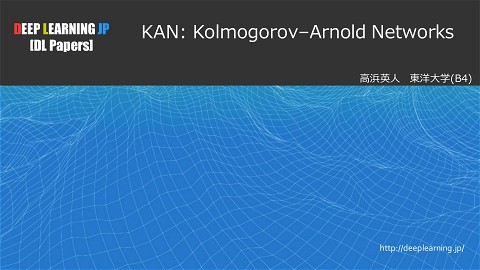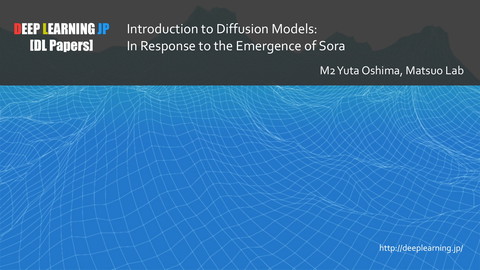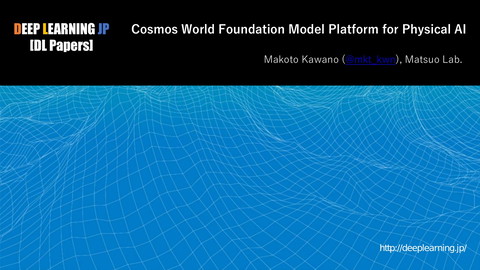【DL輪読会】Understanding In-Context Learning in Transformers and LLMs by Learning to Learn Discrete Functions
14.9K Views
April 04, 24
スライド概要
DL輪読会資料
関連スライド
各ページのテキスト
DEEP LEARNING JP Understanding In-Context Learning in Transformers and LLMs by Learning to Learn Discrete Functions [DL Papers] ⾼城 頌太(東京⼤学 ⼯学系研究科 松尾研 D1) http://deeplearning.jp/ 1
書誌情報 タイトル: Understanding In-Context Learning in Transformers and LLMs by Learning to Learn Discrete Functions https://arxiv.org/abs/2310.03016 ICLR 2024 Oral 著者: Satwik Bhattamishra, Arkil Patel, Phil Blunsom, Varun Kanade University of Oxford, Mila and McGill University, Cohere 概要: 離散関数の学習を通じて,Transformerがin context learningの能⼒を獲得する⽅式について理解 する 選定理由: transformerがin contextで解けるタスクの限界を知りたい & ⾔語にも応⽤したい 2
- https://arxiv.org/abs/2310.03016
- https://arxiv.org/search/cs?searchtype=author&query=Bhattamishra, S
- https://arxiv.org/search/cs?searchtype=author&query=Patel, A
- https://arxiv.org/search/cs?searchtype=author&query=Blunsom, P
- https://arxiv.org/search/cs?searchtype=author&query=Kanade, V
⽬次 1. Introduction & Related Work 2. Set up for in-context learning 3. In-context learning Boolean Functions 4. In-context learning with Teaching Sequences 5. Investigations with Pretrained Models 6. Conclusion 3
⽬次 1. Introduction & Related Work 2. Set up for in-context learning 3. In-context learning Boolean Functions 4. In-context learning with Teaching Sequences 5. Investigations with Pretrained Models 6. Conclusion 4
In-context learningとは? • デモンストレーションの形式でいくつかの例を与えられたときに⾔語モデルがパ ラメータの更新なしにタスクを学習すること 5
関連研究: なぜIn-context learningができるのか? • 事前学習データの分布に関する観点 – Data Distributional Properties Drive Emergent In-Context Learning in Transformers(Neurips 2022) • In-context learningの特性に関する観点 – What Can Transformers Learn In-Context? A Case Study of Simple Function Classes(Neurips 2022) • 理論的アプローチ(メタ学習,勾配降下法との類似点等) – Why Can GPT Learn In-Context? Language Models Implicitly Perform Gradient Descent as Meta-Optimizers(ACL 2023) – What learning algorithm is in-context learning? Investigations with linear models(ICLR 2023) – Transformers learn in-context by gradient descent(ICML 2023) – Transformers as Algorithms: Generalization and Stability in In-context Learning(ICML 2023) 6
本研究でのResearch Question 1. 2. 3. 4. TransformerにおけるIn-context learningの能⼒の限界とは? In-context learningおいてattentionは必要か? Transformerは効率的にexampleを活⽤することができるか? タスク特化で学習していないLLMが⽂脈に従って学習アルゴリズムを実装する ことができるのか? 𝑃! = 𝑥" , 𝑦" , … , 𝑥!#" , 𝑦!#" , 𝑥! → 𝑓(𝑥! ) 𝐷$ 𝐷ℱ 7
本研究での貢献 • In-context learning Boolean functions – ブール関数におけるin-context learningについ て調査 • Teaching Sequences – 関数を⼀意に識別することができるexampleの 集合 – ⼊⼒にteaching sequencesが含まれているか どうかでin context learningの能⼒がどのよう に変化するかを調査 • Investigation with LLMs – LLMで同様の調査 8
⽬次 1. Introduction & Related Work 2. Set up for in-context learning 3. In-context learning Boolean Functions 4. In-context learning with Teaching Sequences 5. Investigations with Pretrained Models 6. Conclusion 9
問題設定 • Baseline – What Can Transformers Learn In-Context? A Case Study of Simple Function Classes(Neurips 2022) • Training sequences – (𝒙" , 𝑓(𝒙" ), … 𝒙& , 𝑓(𝒙& )) • Prompt – 𝑃! = (𝒙" , 𝑦" , … 𝒙!#" , 𝑦!#" , 𝒙! ) • Loss M: Model, N: number of sequences, m: number of examples 𝑓: 0, 1 ! → 0, 1 , 𝑥 ~ 𝐷" , 𝑓 ~ 𝐷ℱ 10
実験設定 • Transformer • LSTM • DSS(state-space model) • Hyena(long convolutional model) • RetNet Model M ※スクラッチで学習 Lossにはcross enorpy, 様々なdepthとwidthで チューニング 11
⽬次 1. Introduction & Related Work 2. Set up for in-context learning 3. In-context learning Boolean Functions 4. In-context learning with Teaching Sequences 5. Investigations with Pretrained Models 6. Conclusion 12
Question 1. トランスフォーマーがコンテキスト内で学習できるブール関数の種類とその制限 は? 2. Attentionはin-context learningに必要か?Atentionとattention freeのモデルの違 いは? 検証タスク • Conjunctions and Disjunctions • DNFs and CNFs • Parities 13
Conjunctions and Disjunctions • 𝑋$ = 0, 1 ! , 𝒙 ∈ 𝑋! の時,⼊⼒の論理和か論理積によって出⼒値が決定される • 以下の論理積(conjunction)の例では n=10 で, x2=1, x6=0, x7=1の時に出⼒が1と なる – ex 0101101000 → 1 • 関数の種類は2%! 個存在する 𝑥! ⋀ 𝑥" ⋀ 𝑥# conjunction 𝑥! ⋁ 𝑥" ⋁ 𝑥# disjunction 14
DNFs and CNFs • DNFs: 論理和標準形 3-DNF: 3つの論理積項の論理和で記述できる形式 ex: (𝑥' ⋀ 𝑥( ⋀ 𝑥) )⋁(𝑥" ⋀ 𝑥* ⋀ 𝑥+ ) ⋁ (𝑥, ⋀ 𝑥( ⋀ 𝑥) ⋀ 𝑥-) • CNFs: 論理積標準形 3-CNF: 3つの論理和項の論理積で記述できる形式 ex: (𝑥' ⋁ 𝑥( ⋁ 𝑥) )⋀(𝑥" ⋁ 𝑥* ⋁ 𝑥+ )⋀(𝑥, ⋁ 𝑥( ⋁ 𝑥) ⋁ 𝑥-) 15
Parities • パリティ関数 – ⼊⼒のsubsetをXORしたものが出⼒ – 1が奇数個あれば1, 偶数個だと0となる関数 – Ex: 11000 → 0, 11111000 → 1 • PARITY-n – 0, 1 . 上の2. 個のすべてのパリティ関数を含む – ex: PARITY-10 → (𝑥" ⊕ 𝑥, ), (𝑥' ⊕ 𝑥* ⊕ 𝑥-), … • PARITY-(n,k) – 0, 1 . 上の変数のうちk個を関連変数として含む – ex: PARITY-(10,3) → (𝑥' ⊕ 𝑥( ⊕ 𝑥) ), … 16
結果 • 複雑なタスクになるほど精度が落ちていき, Parityは全く精度が出ていない • Attention freeのアーキテクチャでも同等の性能が出ているが,⼀番良いのは transoformer • Nearest Neighborでは差が顕著(attentionがあると得意?) 17
結果 • 論理和や論理積のような問題では,勾配降下法で学習したFFNや既存のPAC学習 と同等の性能で,学習に必要なサンプル数も同等 • さらにOODや間違いに対してもロバストであった 18
結果 • Examplesの数を変化させた時の正解率 19
結果 20
⽬次 1. Introduction & Related Work 2. Set up for in-context learning 3. In-context learning Boolean Functions 4. In-context learning with Teaching Sequences 5. Investigations with Pretrained Models 6. Conclusion 21
Question • Transformerは効率的にexampleを活⽤することができるか? Teaching Sequences(Goldman & Kearns, 1995) - 関数を⼀意に識別することができるexampleの集合(𝑥&, 𝑓(𝑥&), … 𝑥' , 𝑓(𝑥' )) - 作り⽅はAppendix Fを参照 22
実験設定 Model: transformer Data: 最初のt個のexampleをteaching sequences,残りのm-t個は𝐷" からサンプル Task: Conjunctions, Disjunctions, CNFs and DNFs, and sparse parities 23
結果 • 全てのタスクにおいてtransoformerが100%に近い精度 • Teaching sequenceが与えられとParityでも性能が出る – Vanillaだと学習できなかった 24
学習時にTeaching sequencesを混合させる • 学習時にteaching sequencesを⽤いてtestに⽤いない場合 • 学習時にteaching sequencesをも⽤いずに,testに⽤いる場合 • 学習時に1/2の確率でteaching sequencesを⽤いてtestに⽤いない場合 • 学習時に1/2の確率でteaching sequencesを⽤いてtestに⽤いる場合 Mixした場合は2つのアルゴリズムを学習している?(と著者が⾔っているが不明) 25
余談: two distinct algorithms • Reviewerからも質問されていた 26
⽬次 1. Introduction & Related Work 2. Set up for in-context learning 3. In-context learning Boolean Functions 4. In-context learning with Teaching Sequences 5. Investigations with Pretrained Models 6. Conclusion 27
Question • 事前学習されたLLMが 𝑃( = 𝑥&, 𝑦&, … , 𝑥()& , 𝑦()&, 𝑥( という形式のプロンプトを与 えられた時にどのようなタスクなら解けるか Transformer persorms Good! LLM persorms Good? 28
実験設定 1. Frozen GPT model: Pretrained GPT-2(input and output layerのみ学習, その他はfrozen) task: conjunctions, nearest neighbours 2. Direct Evaluation model: gpt-4, gpt-3.5-turbo, llama2-70b task: conjunctions, majorities 29
結果: Frozen GPT • 他のベースラインと⽐較して良い性能だが,fullly trainingの性能には届かない • GPT-2はNearest Neighboursを実装できる – Exampleの最初の20個にラベルをつけ,続く80点を最近傍により予測 – ほぼ100%に近い精度を達成 – モデルのattention headを調査すると,これまでのプロンプトから最近傍のxのラベルyに着⽬ するようなheadが発⾒された(induction head) 30
結果: Direct Evaluation • {0, 1}^n の次元数が7までの場合はNNと同等以上の性能 • 15を超えると怪しい,gpt-4はそれでも⾼い性能 31
⽬次 1. Introduction & Related Work 2. Set up for in-context learning 3. In-context learning Boolean Functions 4. In-context learning with Teaching Sequences 5. Investigations with Pretrained Models 6. Conclusion 32
Conclution Contributions • In-context learning Boolean functions • Teaching Sequences • Investigation with LLMs Future works • LLMで⾔語タスクでサンプル効率よくin-context learningできないか • 陽にmeta-learningを⾏なっていないにも関わらず,アルゴリズムをin-contextで 学習できる能⼒が⾝につくのはなぜか • In-context learningでparityの学習が難しい理論的な背景とは • 様々なアーキテクチャでin-context learningができるメカニズムは何か 33
感想(適当に⾔ってます) • 基本的にはcontextのx, yペアに線形な関係がある場合のみうまくいってそうに⾒ えるがteaching sequencesが⾒つかればPARITYのように⾮線形な関係でもICLで きる? • teaching sequencesが⾒つかる = 完全にタスクが同定できている状態 – ICLにおけるタスクベクトルなど.. – https://arxiv.org/abs/2212.04089 • ブール関数だけじゃなく,⾔語でやりたい – その場合の teaching sequencesとは? • LLMだとICLは結局最近傍を⾒つけているだけ? – そんなわけはなさそう(cotとかは説明できなそう) – そもそもpretrainでなぜそのような能⼒が⾝につくのか – 他のアーキテクチャだと最近傍⾒つける能⼒低いのなぜ 34
Thank you. 35







